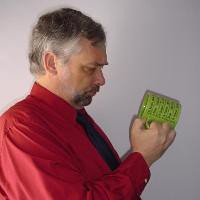Note: Visit my education blog, The Green Cup.
I spent today at a workshop on autism. It was the second such workshop in a series of four presented by the West Virginia Autism Training Center at Marshall University. Like most such workshop, this series is not purely informational. It is designed to promote an approach to dealing with autism in the classroom (and other settings). The approach is called Positive Behavior Support.
Autism has been in the news a lot over the past couple of years. A number of controversies surround the disorder - chief among them is the increase in the number of cases of autism being reported. Thirty years ago autism was a relatively rare condition that ordinary people knew little about. Many medical professional either considered it a form of mental retardation or (worse) simply mistook it for mental retardation. Today the most common estimate is that one in every 166 children is born with autism. Since four out of every five cases of autism occur in boy, that means that about one out of ever 415 girls is born with autism and one our of about every 103 boys is born with autism.
Why are there more cases now? That question could start fist fights. On the one hand is the suggestion that, just maybe, the biggest reason is that we've learned to recognize autism better and the second biggest reason is that we've changed who gets to keep the count. Under this theory, we've always had about this many autistic children, we just called them something else - mentally impaired, or learning disabled, or emotionally disturbed. The reported number of cases is also up because before the 1990's doctors, for the most part, reported on the number of autism cases; under the Child Find provisions of Individuals with Disabilities Education Act (IDEA), schools took over the responsibility of reporting the statistics. And it became an obligation - not just to report cases that showed up, but to go out and find those children and identify them.
The definition of autism has also been altered and expanded along the way. The Diagnostic and Statistical Manual of Mental Disorders (DSM) is the book doctors use to identify autism. The definition in the DSM-III published in 1980 differed from that in DSM-IIIR published in 1987. It was changed again in the DSM-IV(TR) published in 1994.
Other disorders, like Asperger Syndrome, have been grouped together as being related in some way to autism. And when a child doesn't quite meet the definition of autism, professionals will describe the child as falling under the umbrella of "autism spectrum" - disorders that can't be clearly identified but resemble autism.
The workshops have been interesting. The first one was mostly an introduction. among the topics that got floated and discussed: the genetics of autism, the possibility that autism is an evolutionary adaptation (not sure I buy that), the question of whether famous people are autistic (Bill Gates was mentioned), and more.
The workshop today dealt with identifying the causes of problem behavior and how to find solutions for them. Functional Behavior Assessment...
Two more workshops to go.
Thursday, December 13, 2007
Subscribe to:
Post Comments (Atom)


No comments:
Post a Comment